仁爱版英语八下U8T2SC
仁爱版英语八年级下册Unit 8 Topic 2《We can design our own uni
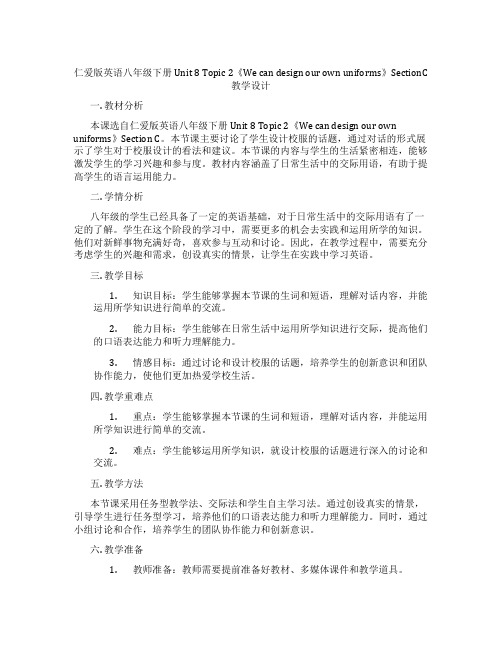
仁爱版英语八年级下册Unit 8 Topic 2《We can design our own uniforms》SectionC教学设计一. 教材分析本课选自仁爱版英语八年级下册Unit 8 Topic 2《We can design our own uniforms》Section C。
本节课主要讨论了学生设计校服的话题,通过对话的形式展示了学生对于校服设计的看法和建议。
本节课的内容与学生的生活紧密相连,能够激发学生的学习兴趣和参与度。
教材内容涵盖了日常生活中的交际用语,有助于提高学生的语言运用能力。
二. 学情分析八年级的学生已经具备了一定的英语基础,对于日常生活中的交际用语有了一定的了解。
学生在这个阶段的学习中,需要更多的机会去实践和运用所学的知识。
他们对新鲜事物充满好奇,喜欢参与互动和讨论。
因此,在教学过程中,需要充分考虑学生的兴趣和需求,创设真实的情景,让学生在实践中学习英语。
三. 教学目标1.知识目标:学生能够掌握本节课的生词和短语,理解对话内容,并能运用所学知识进行简单的交流。
2.能力目标:学生能够在日常生活中运用所学知识进行交际,提高他们的口语表达能力和听力理解能力。
3.情感目标:通过讨论和设计校服的话题,培养学生的创新意识和团队协作能力,使他们更加热爱学校生活。
四. 教学重难点1.重点:学生能够掌握本节课的生词和短语,理解对话内容,并能运用所学知识进行简单的交流。
2.难点:学生能够运用所学知识,就设计校服的话题进行深入的讨论和交流。
五. 教学方法本节课采用任务型教学法、交际法和学生自主学习法。
通过创设真实的情景,引导学生进行任务型学习,培养他们的口语表达能力和听力理解能力。
同时,通过小组讨论和合作,培养学生的团队协作能力和创新意识。
六. 教学准备1.教师准备:教师需要提前准备好教材、多媒体课件和教学道具。
2.学生准备:学生需要提前预习教材,了解本节课的内容。
七. 教学过程1.导入(5分钟)教师通过向学生展示不同学校的校服,引导学生谈论他们对校服的看法。
仁爱英语八下Unit 8 Topic 2 Section C
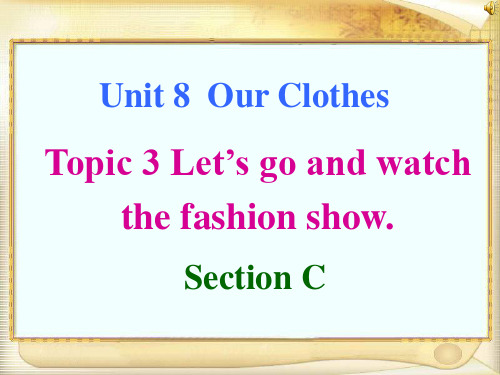
stand for 代表 get its name 得名 from then on 从那时起 不仅……而且…… not only … but also 在其他的亚洲国家 in other Asian countries 美丽的丝扣 beautiful silk knots 或者……或者…… either…or… 穿戴者的个人风格 the wearer’s personal style 丰富的传统文化 rich traditional culture
Guessing Game
What’s this?
Tang costume
What’s this?
sportswear
wedding dress
What’s this?
What’s this?
business suit
What’s this?
Zhongshan costume
What’s this?
Write a letter to your pen friend about Tang costume and cheongsam.
Features of Tang costume:
• Dynasty of beginning: Han and Tang dynasties ______________________________ • Material: ______________________________ silk • Wearer: ______________________________ people all over the world • Occasion(场合): ______________________________ either formal or casual • Decoration: ______________________________ beautiful silk knots and others
仁爱版英语八年级下册Unit8 Topic2 教材知识详解

Unit8 Topic2 教材知识详解1. Could you tell me when you wear your uniforms? 你能告诉我,你们什么时候穿制服吗?when引导宾语从句时意为“何时,什么时候”。
如:Do you know when they will come? 你知道他们什么时候会来吗?2. We usually wear uniforms when we are at work, but sometimes we wear plain clothes to carry out special tasks.我们通常上班期间穿制服,但有时穿便衣执行特殊任务。
(1) plain adj.意为“普通的,家常的”。
如:plain clothes 便衣;plain people 普通人;a plain meal 一顿便饭(2)carry out意为“执行,实施,履行”。
如:Let’s carry out the plan!让我们把计划付诸行动吧!3. And our uniforms may stop some people from doing bad things.我们的制服可以防止一些人干坏事。
stop … from doing= keep … from doing … 意为“阻止,防止……做……”。
如:Don’t stop them from reading English. 别阻止他们读英语。
4. People should dress correctly. 人们应该着装得体。
dress在这里是动词,意为“穿衣服”。
【辨析】dress, wear, put on(1) wear意为“穿着、戴着”、指穿戴的状态,后面接表示服装的词,可以用进行时态。
如:She is wearing a red coat. 她穿着一件红色的外色。
(2) put on意为“穿載”,指穿戴的动作。
八年级英语仁爱版下册_Unit8_Topic2_SectionC_优质课课件
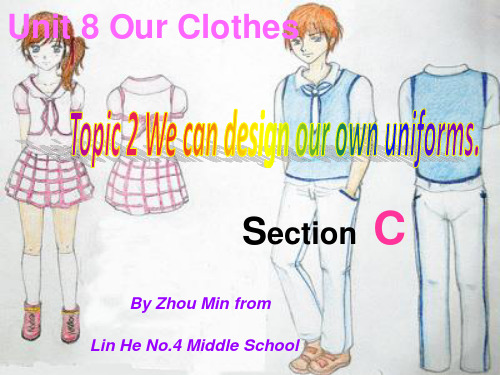
eyes __f_r_o_m___the sun.
读后抓巩固
3.当我们在机场看见航空公司飞行员穿着制服时, 我们相信他们知道怎样驾驶飞机。
When we __se_e__airline pilots __w_e_a_r_in__g_ uniforms at the airport, we believe that they know __h_o_w__t_o____/_h_o_w__t_h_e_y_c_a_n__fl_y_ fly the plane. 4. 所以对于我们来说了解日常生活中的不同制服
Read and pay attention to the pronunciation and intonation. (朗读能力需加强)
读后抓巩固
1.消防人员穿特殊服装和戴头盔是为了保护他们自 己免受高温和坠落的天花板的伤害。
Firefighters wear special coats and helmets
magazine?
2. Because they can protect themselves from
2h.eWathaynddofafilrleinfigghcteeirlisnwgsea.r special coats and helmets?
33..WWheaktncoanwwweekcnaonwgieftwheelspeefraompohliicme oofrfihceerr. in uniform?
是有必要的。
So it's _n_e_c_e_ss_a_r_y_ for us ____to__k_n_o_w______ different uniforms ___i_n_o_u_r__d_a_il_y_l_i_fe___ficial uniforms
八下仁爱版英语课文u8t2
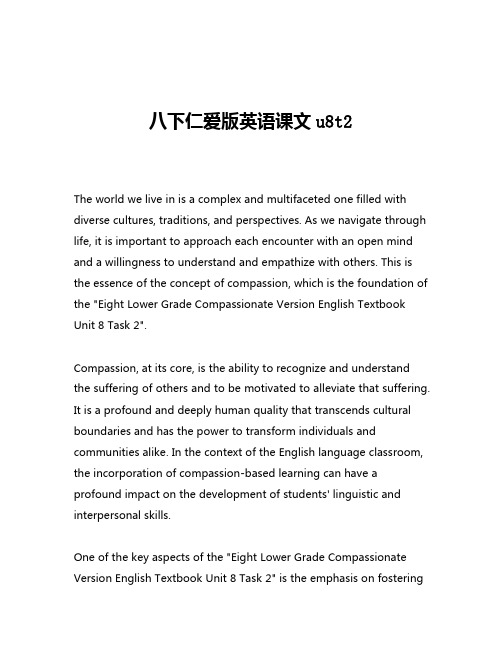
八下仁爱版英语课文u8t2The world we live in is a complex and multifaceted one filled with diverse cultures, traditions, and perspectives. As we navigate through life, it is important to approach each encounter with an open mind and a willingness to understand and empathize with others. This is the essence of the concept of compassion, which is the foundation of the "Eight Lower Grade Compassionate Version English Textbook Unit 8 Task 2".Compassion, at its core, is the ability to recognize and understand the suffering of others and to be motivated to alleviate that suffering. It is a profound and deeply human quality that transcends cultural boundaries and has the power to transform individuals and communities alike. In the context of the English language classroom, the incorporation of compassion-based learning can have a profound impact on the development of students' linguistic and interpersonal skills.One of the key aspects of the "Eight Lower Grade Compassionate Version English Textbook Unit 8 Task 2" is the emphasis on fosteringempathy and understanding among students. Through carefully curated reading materials, engaging discussions, and interactive activities, students are encouraged to step into the shoes of others and to consider perspectives that may differ from their own. This not only enhances their language proficiency but also cultivates a deeper appreciation for the diversity of human experiences.The textbook's content is designed to expose students to a wide range of real-world scenarios and narratives that highlight the challenges and triumphs of individuals from various backgrounds. From stories of overcoming adversity to accounts of cross-cultural collaboration, the materials provide a rich tapestry of perspectives that challenge students to think critically and engage meaningfully with the subject matter.One particularly powerful aspect of the "Eight Lower Grade Compassionate Version English Textbook Unit 8 Task 2" is its focus on developing students' emotional intelligence. By encouraging self-reflection, promoting active listening, and fostering constructive dialogue, the textbook helps students to better understand their own emotions and those of their peers. This, in turn, equips them with the necessary skills to navigate complex social situations, resolve conflicts, and build meaningful relationships.Moreover, the textbook's emphasis on compassion-based learningextends beyond the classroom walls. Through carefully designed service-learning projects and community engagement activities, students are given the opportunity to apply their newfound knowledge and skills in real-world contexts. This not only reinforces their language proficiency but also instills a sense of social responsibility and a desire to make a positive impact on their communities.The "Eight Lower Grade Compassionate Version English Textbook Unit 8 Task 2" is a testament to the transformative power of education. By prioritizing compassion as a core tenet of language learning, the textbook sets the stage for the development of well-rounded individuals who are not only proficient in the English language but also possess the empathy, critical thinking, and problem-solving skills necessary to navigate the complexities of the modern world.As students engage with the textbook's content, they are encouraged to reflect on their own biases, challenge their preconceptions, and develop a deeper understanding of the human experience. This process of self-discovery and growth is not only valuable for their academic and personal development but also has the potential to ripple outward, influencing their interactions with family, friends, and their broader community.In conclusion, the "Eight Lower Grade Compassionate Version English Textbook Unit 8 Task 2" represents a innovative and holistic approach to language education. By seamlessly integrating compassion-based learning into the curriculum, the textbook equips students with the linguistic and interpersonal skills necessary to thrive in an increasingly interconnected world. As they navigate the rich and diverse content of the textbook, students are empowered to become agents of positive change, using their newfound knowledge and understanding to build a more just, equitable, and compassionate society.。
八年级仁爱版下册u8t2知识点

八年级仁爱版下册u8t2知识点本文将为大家介绍八年级仁爱版下册英语Unit 8 Topic 2(U8T2)的知识点,包括词汇、语法、听力和口语等方面。
一、词汇1. arrange v. 安排,布置E.g. Have you arranged the furniture in your new apartment yet?你已经在新公寓里安排好家具了吗?2. camp n. 露营地,营地;v. 去露营,扎营E.g. We went camping last weekend and had a great time.上周末我们去露营了,过得很愉快。
3. charity n. 慈善机构,慈善事业E.g. The charity run raised a huge amount of money for the local children's hospital.这次慈善长跑为当地的儿童医院筹集了大量的资金。
4. collect v. 收集,募捐;n. 收藏品E.g. The school is collecting donations for the local food bank.学校正在为当地的食品银行募集捐款。
5. community n. 社区,社会E.g. Our neighborhood is a very friendly and supportive community.我们的社区非常友好和支持。
6. contribute v. 贡献,捐款E.g. She has contributed a lot of time and effort to the local animal shelter.她为当地的动物收容所做出了很多时间和努力的贡献。
7. donation n. 捐赠,捐款E.g. The company made a large donation to the local homeless shelter.公司为当地的无家可归者收容所进行了大笔捐赠。
最新仁爱版八年级英语下册U8T2(p3)优质教学设计
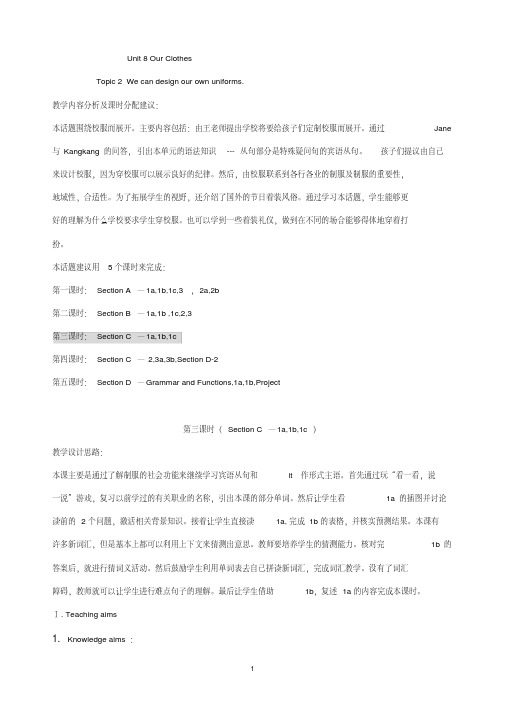
Unit 8 Our ClothesTopic 2 We can design our own uniforms.教学内容分析及课时分配建议:本话题围绕校服而展开。
主要内容包括:由王老师提出学校将要给孩子们定制校服而展开。
通过Jane 与Kangkang 的问答,引出本单元的语法知识---从句部分是特殊疑问句的宾语从句。
孩子们提议由自己来设计校服,因为穿校服可以展示良好的纪律。
然后,由校服联系到各行各业的制服及制服的重要性,地域性,合适性。
为了拓展学生的视野,还介绍了国外的节日着装风俗。
通过学习本话题,学生能够更好的理解为什么学校要求学生穿校服。
也可以学到一些着装礼仪,做到在不同的场合能够得体地穿着打扮。
本话题建议用5个课时来完成:第一课时:Section A—1a,1b,1c,3,2a,2b第二课时:Section B—1a,1b ,1c,2,3第三课时:Section C—1a,1b,1c第四课时:Section C— 2,3a,3b,Section D-2第五课时:Section D—Grammar and Functions,1a,1b,Project第三课时(Section C—1a,1b,1c)教学设计思路:本课主要是通过了解制服的社会功能来继续学习宾语从句和it作形式主语。
首先通过玩“看一看,说一说”游戏,复习以前学过的有关职业的名称,引出本课的部分单词。
然后让学生看1a的插图并讨论读前的2个问题,激活相关背景知识。
接着让学生直接读1a,完成1b的表格,并核实预测结果。
本课有许多新词汇,但是基本上都可以利用上下文来猜测出意思。
教师要培养学生的猜测能力。
核对完1b的答案后,就进行猜词义活动。
然后鼓励学生利用单词表去自己拼读新词汇,完成词汇教学。
没有了词汇障碍,教师就可以让学生进行难点句子的理解。
最后让学生借助1b,复述1a的内容完成本课时。
Ⅰ. Teaching aims1.Knowledge aims:(1)学习并掌握新词汇text,reason,heat,airport,officer,patient,spread,daily,firefighter,solider,official(2)继续学习宾语从句和it作形式主语的句型。
仁爱版八年级英语下册课件:Unit 8Topic 2 Section C(共27张PPT)
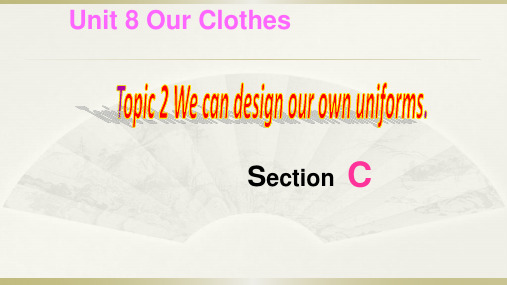
Look at the pictures and make sentences with It's +adj.+(for sb.) to do sth.and It's+ adj. +that...
fight with each other wear hats in class wear business suits
soldier green clothes
to protect themselves in the forest
official official uniforms to make themselves look important
airline pilot pilot uniforms
to make us believe that they
Unit 8 Our Clothes
Section C
text reason firefighter heat ceiling soldier official airport
n.正文,文本 n.原因,理由 n.消防人员 n.温度,热 n.天花板,顶棚 n.士兵,战士 n.官员,高级职员 n.航空站,飞机场
2. When we see airline pilots wearing uniforms at the airport,we believe that they
know how to fly the plane. 当我们在机场看见航空公司飞行员穿着制服时,我们相信他们知道怎样驾
驶飞机。 (1)when引导一个时间状语从句,在主句中又包含了由that引导的宾语从句,
It’s also important that people should dress correctly.
(word完整版)新版仁爱英语八年级下册unit8topic2知识点,推荐文档
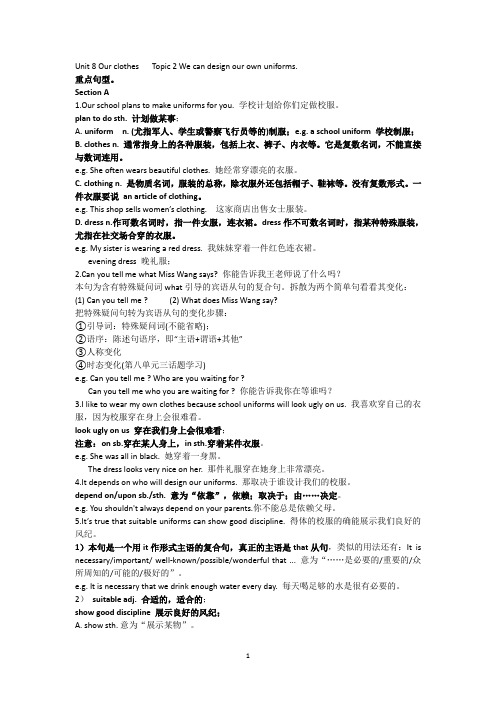
Unit 8 Our clothes Topic 2 We can design our own uniforms.重点句型。
Section A1.Our school plans to make uniforms for you. 学校计划给你们定做校服。
plan to do sth. 计划做某事;A. uniform n. (尤指军人、学生或警察飞行员等的)制服;e.g. a school uniform 学校制服;B. clothes n. 通常指身上的各种服装,包括上衣、裤子、内衣等。
它是复数名词,不能直接与数词连用。
e.g. She often wears beautiful clothes. 她经常穿漂亮的衣服。
C. clothing n. 是物质名词,服装的总称,除衣服外还包括帽子、鞋袜等。
没有复数形式。
一件衣服要说an article of clothing。
e.g. This shop sells women’s clothing. 这家商店出售女士服装。
D. dress n.作可数名词时,指一件女服,连衣裙。
dress作不可数名词时,指某种特殊服装,尤指在社交场合穿的衣服。
e.g. My sister is wearing a red dress. 我妹妹穿着一件红色连衣裙。
evening dress 晚礼服;2.Can you tell me what Miss Wang says? 你能告诉我王老师说了什么吗?本句为含有特殊疑问词what引导的宾语从句的复合句。
拆散为两个简单句看看其变化:(1) Can you tell me ? (2) What does Miss Wang say?把特殊疑问句转为宾语从句的变化步骤:①引导词:特殊疑问词(不能省略);②语序:陈述句语序,即“主语+谓语+其他”③人称变化④时态变化(第八单元三话题学习)e.g. Can you tell me ? Who are you waiting for ?Can you tell me who you are waiting for ? 你能告诉我你在等谁吗?3.I like to wear my own clothes because school uniforms will look ugly on us. 我喜欢穿自己的衣服,因为校服穿在身上会很难看。
仁爱版英语八下Unit8Topic2SectionC (1)

相信你完全可以掌握这节课的内容.加油哦!
Object Clauses
you give ICan want to fly. me a cake?
Why can’t I wear beautiful clothes?
The models are wearing a suit of fashional clothes.
Let’s make our school better!
1. Learn some new words: gatekeeper, attendant, enter, knee, occasion, correctly, 2. Learn that it’s adj for sb to do sth. 3. Learn that: We should wear suitable clothes on every occasion. People should dress correctly.
We can design our own uniforms.
Section B
Learning aims
1.掌握新单词和词组:
gatekeeper, attendant, enter, occation, knee,
correctly, take off等。
2.复习宾语从句。 3.谈论不同场合的不同着装礼仪。
using It's +adj.+(for sb.) to do sth. or It's +adj.+that...
obey the traffic rules
It's necessary/right that everyone obeys the traffic rules.
仁爱英语八下U8T2SC
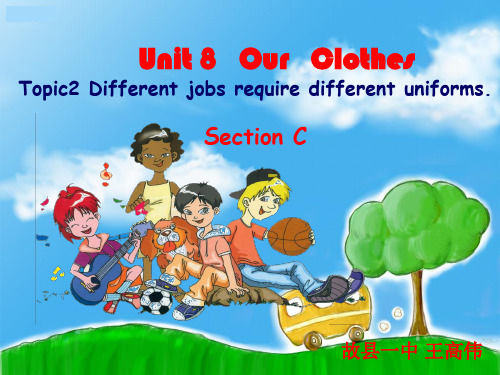
pilot ['paɪlət] n. 飞行员
这场事故是飞行员的失误造成的。 pilot The _______ was caused by ______error. accident
airport n. 机场
official /ə‘fɪʃəl/ 军官,官员
His father is an official. 他父亲是一位军官。
2
Work alone
A. Listen to the passage carefully, and check(√) the clothes Li Mei likes wearing during the year.
1( √ )
2(
)
3( √
)
4(
)
5(
)
6( √ )
7( √ )
8( √ )
9(
4.Who can help us if we have a car accident on the street? A police officer or a soldier can help us if we have a car accident on the street.
Guess their jobs from their uniforms
Soldiers wear green clothes to help them to hide in the forest
3.How do officials look when they dress in their uniforms? When officials dress in their uniforms, they look important.
)
仁爱版初中英语八年级下册Unit8Topic2Sectionc课件(共26张PPT)_10
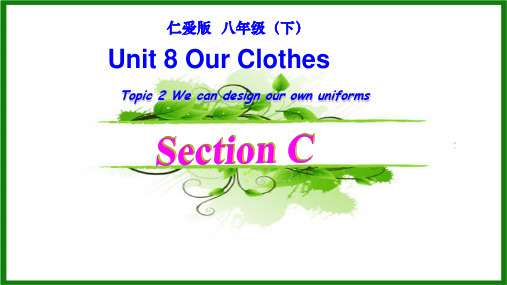
Most people believe we should dress_c_o_r_re_c_t_ly___(correct/correctly) on every occasion. What's more, we should choose different clothes in different seasons. In China,the temperature changes__g_r_e_a_tl_y__ (great/ greatly), so the clothes people wear in each season are very different. Li Mei comes from_n_o_rt_h_e_r_n_(northern/north) China. In spring,it is windy there,so Li Mei likes to wear a windbreaker.She likes summer very much because she can wear different colorful clothes,__s_u_c_h___a_s__(for example/such as) shorts, T-shirts and dresses. In fall, it is ____c_o_o_l__ (cool/cold). Li Mei likes to wear casual clothes, especially jeans. They make her look_b__e_a_u_ti_fu_l__(beautiful/ beautifully). In winter it is _c_o_l_d__ (cool/cold)there. She usually wears a sweater or __o_t_h_e_r _(other/another) warm clothes and boots.
仁爱版英语八年级下册《Unit Eight Topic Two SectionC》课件

3. Writing: Be able to write a simple passage about your opinions.
4. Where is the Boda Park? Could you tell me? (合并为一句) _C_o_u_l_d_y_o_u__t_e_ll_m__e_w__h_e_r_e_t_h_e_B_o_d__a_P_a_r_k__is__?______________
1a. Look at the pictures and discuss the following questions with your partner. Then read and compare your opinions with the writer’s.
9.(某人来)做…是…的 _I_t _is_+__a_d_j._+_(_fo_r_/_o_f_s_b_.)__to__d_o_s_t_h_.=__It is +adj.+that ..
10. 给某人穿什么衣服 _d_r_e_s_s_s_b_._in__+__衣__物__或__颜__色________
to look important to make us believe that they know how to fly the plane
to let us know we can get help from them
2. Black clothes are suitable for a fat person. (改为同义句) _I_t’_s_ suitable _t_h_a_t a fat person wears black clothes.
仁爱版八年级英语下册全册教案Unit 8 Our Clothes Topic 2 Section C
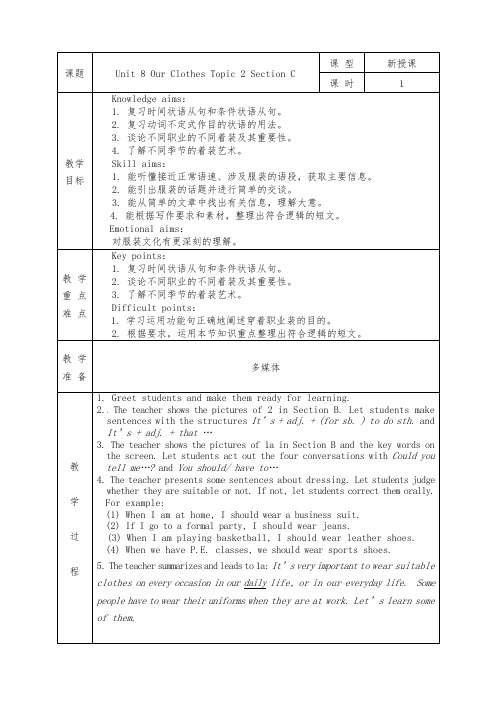
课题Unit 8 Our Clothes Topic 2 Section C 课型新授课课时 1教学目标Knowledge aims:1. 复习时间状语从句和条件状语从句。
2. 复习动词不定式作目的状语的用法。
3. 谈论不同职业的不同着装及其重要性。
4. 了解不同季节的着装艺术。
Skill aims:1. 能听懂接近正常语速、涉及服装的语段,获取主要信息。
2. 能引出服装的话题并进行简单的交谈。
3. 能从简单的文章中找出有关信息,理解大意。
4. 能根据写作要求和素材,整理出符合逻辑的短文。
Emotional aims:对服装文化有更深刻的理解。
教学重点难点Key points:1. 复习时间状语从句和条件状语从句。
2. 谈论不同职业的不同着装及其重要性。
3. 了解不同季节的着装艺术。
Difficult points:1. 学习运用功能句正确地阐述穿着职业装的目的。
2. 根据要求,运用本节知识重点整理出符合逻辑的短文。
教学准备多媒体教学过程1. Greet students and make them ready for learning.2. The teacher shows the pictures of 2 in Section B. Let students make sentences with the structures It’s + adj. + (for sb. ) to do sth. and It’s + adj. + that …3. The teacher shows the pictures of 1a in Section B and the key words on the screen. Let students act out the four conversations with Could you tell me…? and You should/ have to…4. The teacher presents some sentences about dressing. Let students judgewhether they are suitable or not. If not, let students correct them orally. For example:(1) When I am at home, I should wear a business suit.(2) If I go to a formal party, I should wear jeans.(3) When I am playing basketball, I should wear leather shoes.(4) When we have P.E. classes, we should wear sports shoes.5. The teacher summarizes and leads to 1a: It’s very important to wear suitable clothes on every occasion in our daily life, or in our everyday life. Some people have to wear their uniforms when they are at work. Let’s learn some of them.1. The teacher lets students look at Picture 1 of 1a and adds a pictureof officials. Let students discuss the jobs of the people in the pictures with their partner. Teach the words firefighter, heat and ceiling byintroducing the firefighter in the picture. Teach the words soldier, official, officer and patients by showing their pictures. Teach the word airport by explaining that the pilot works in the airport. Teach the words reason and spread by showing their Chinese meanings.2. The teacher asks students to observe the pictures again and discuss whatfunctions of their uniforms are.3. The teacher lets two or three students speak out their opinions.4. The teacher asks students to skim the passage and compare their opinionswith the writer’s.5. The teacher asks students to read the passage again and answer thequestions: How many kinds of uniforms are there in the text? What are they? Teach the new word text.6. The teacher lets two or three students tell their answers.1. The teacher plays the recording sentence by sentence.2. The teacher plays the recording without stopping.3. The teacher asks students to complete the table of 1b.4. The teacher asks two students to tell the answers. Remind them to pay attention to the usage of infinitives (to +v.).5. The teacher lets students find out the object clauses, adverbial clausesof time and condition as well as difficult points. Solve the difficult points together with the students.(1) Firefighters wear special coats and helmets to protect themselvesfrom heat and falling ceilings.(2) When we see airline pilots wearing uniforms at the airport, we believe that they know how tofly the plane.(3) If we have a car accident on the street and we see a police officerin uniform, we know we can get help from him or her.6. The teacher lets students prepare to retell the passage with the help of 1b within their groups.1. The teacher lets students discuss with their group members whether students should wear uniforms at school. Allow them to have their own opinions. Teach the new word opinion and the phrase in one’s opinion.2. The teacher lets the representative of each group report their opinions.3. The teacher lets the students write a passage about the opinions of theirown groups.4. The teacher evaluates their reports. And stress the advantage andimportance of dressing school uniforms.5. The teacher asks students to learn the new words in the brackets of3a by themselves with the help of the similar words. Teach the newwords boot and casual clothes by showing the pictures of them.(1) great → greatlybeautiful → beautifully(2) north +ern → northernsouth + ern → southerneast + ern → easternwest+ ern → western6. The teacher lets students skimthe passage of 3a and know about the generalideas. Then let the choose the correct words to complete the passage.7. The teacher lets two students report their answers.1. The teacher asks the students to read 3a again and fill in the tableof 3b.2. The teacher lets two students tell the answers.3. The teacher lets students work in pairs. Let them survey their partner’s favorite clothes in different seasons and complete the table.Season Clothesspringsummerfallwinter4. The teacher lets students report the result of the survey.5. The teacher guides students to write a passage according to their report.6. The teacher lets two students write down their passages on the blackboard.Then revise them together with the students.7. The teacher shows the summary of this section to the students.8. The teacher assigns homework:(1) Review the summary after class.(2) Write a passage about your family’s job and their uniforms.(3) Preview section D.作业布置完成同步练习课堂总结Students learn a lot about the importance of uniforms. Many of them didn’t like wearing the school uniforms before, but now they know it’s necessary for them to wear the school uniforms. The teacher may design more sentences or draw some pictures about dressing suiting different jobs, seasons, occasions and so on, let students judge whether they are suitable or not.。
仁爱初中英语八年级下册精品教案U8T2(p5)
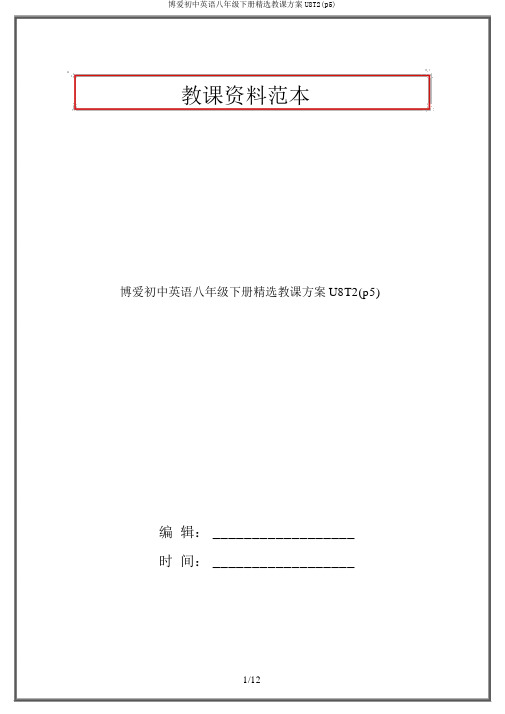
教课资料范本博爱初中英语八年级下册精选教课方案U8T2(p5)编辑: __________________时间: __________________教课内容剖析及课时分派建议:本话题环绕校服而睁开。
主要内容包含:由王老师提出学校将要给孩子们定制校服而睁开。
经过 Jane与Kangkang 的问答,引出本单元的语法知识 ---从句部分是特别疑问句的宾语从句。
孩子们建议由自己来设计校服,由于穿校服能够展现优秀的纪律。
而后,由校服联系到各行各业的制服及制服的重要性,地区性,适合性。
为了拓展学生的视线,还介绍了外国的节日着装民俗。
经过学习本话题,学生能够更好的理解为何学校要修业生穿校服。
也能够学到一些着装礼仪,做到在不一样的场合能够得体地衣着妆扮。
本话题建议用 5个课时来达成:第一课时: Section A —1a,1b,1c,3 ,2a,2b第二课时: Section B — 1a,1b ,1c,2,3第三课时: Section C — 1a,1b,1c第四课时: Section C — 3a,3b,2,Section D-2第五课时: Section D — Grammar and Functions,1a,1b,Project第五课时( Section D —Grammar and Functions,1a,1b,Project)教课方案思路:本课主假如概括总结宾语从句和 it作形式主语的用法同时认识北佳人们的着装习惯。
第一教师指引学生概括总结宾语从句和 it 作形式主语的用法,达成 Grammar和 Functions 两个部分。
而后把 1b的问题作为 Pre-reading,让学生议论,导入到1a 。
随后让学生读 1a,认识北佳人们的着装习惯,同时检测学生在 Pre-reading环节的作答状况,达成1b。
接着让学生再读 1a,从短文中找出用英语释义的单词,培育学生用英语学英语的能力。
教师在解决难点句子的过程中,让学生理解含有退步状语从句和主语从句的句子。
仁爱版八年级英语下册八下U8T2 复习教案
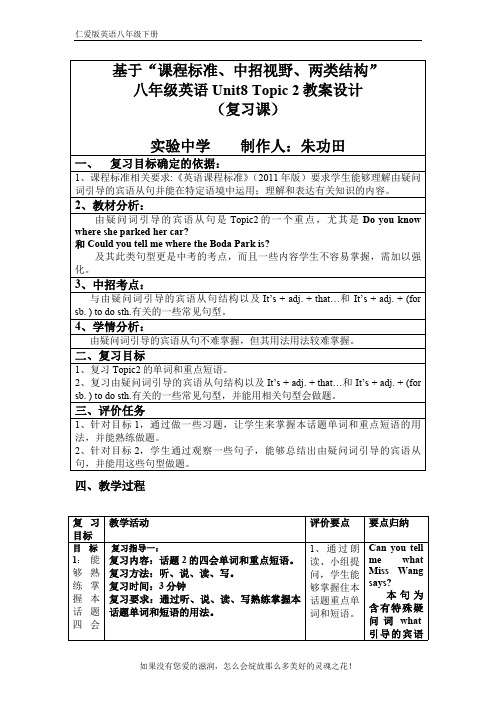
基于“课程标准、中招视野、两类结构”八年级英语Unit8 Topic 2教案设计(复习课)实验中学制作人:朱功田一、复习目标确定的依据:1、课程标准相关要求:《英语课程标准》(2011年版)要求学生能够理解由疑问词引导的宾语从句并能在特定语境中运用;理解和表达有关知识的内容。
2、教材分析:由疑问词引导的宾语从句是Topic2的一个重点,尤其是Do you know where she parked her car?和 Could you tell me where the Boda Park is?及其此类句型更是中考的考点,而且一些内容学生不容易掌握,需加以强化。
3、中招考点:与由疑问词引导的宾语从句结构以及It’s + adj. + that…和 It’s + adj. + (for sb. ) to do sth.有关的一些常见句型。
4、学情分析:由疑问词引导的宾语从句不难掌握,但其用法用法较难掌握。
二、复习目标1、复习Topic2的单词和重点短语。
2、复习由疑问词引导的宾语从句结构以及It’s + adj. + that…和 It’s + adj. + (for sb. ) to do sth.有关的一些常见句型,并能用相关句型会做题。
三、评价任务1、针对目标1,通过做一些习题,让学生来掌握本话题单词和重点短语的用法,并能熟练做题。
2、针对目标2,学生通过观察一些句子,能够总结出由疑问词引导的宾语从句,并能用这些句型做题。
四、教学过程复习目标教学活动评价要点要点归纳目标1:能够熟练掌握本话题四会复习指导一:复习内容:话题2的四会单词和重点短语。
复习方法:听、说、读、写。
复习时间:3分钟复习要求:通过听、说、读、写熟练掌握本话题单词和短语的用法。
1、通过朗读、小组提问,学生能够掌握住本话题重点单词和短语。
Can you tellme whatMiss Wangsays?本句为含有特殊疑问词what引导的宾语单词和重点短语,并能运用这些单词和短语。
- 1、下载文档前请自行甄别文档内容的完整性,平台不提供额外的编辑、内容补充、找答案等附加服务。
- 2、"仅部分预览"的文档,不可在线预览部分如存在完整性等问题,可反馈申请退款(可完整预览的文档不适用该条件!)。
- 3、如文档侵犯您的权益,请联系客服反馈,我们会尽快为您处理(人工客服工作时间:9:00-18:30)。
3. Learn the functions of different uniforms:
Firefighters wear special coats and helmets to protect themselves from heat and falling ceilings.
Soldiers wear green clothes to help them to hide in the forest.
pollution.
B. protect, it D. protect, out
( A ) 3. Soldiers wear green clothes to help them
A. to hide
B. hiding
C. hides
D. hided
1. Where did you hide ____(把…藏起来)the money?
Pre-reading questions:
1. What do you know about uniforms?
2. Is it important for us to wear uniforms? Why?
1a
Read and understand
Uniforms
Uniforms have many uses in our lives. We students wear uniforms at school to show good discipline. Firefighters wear special coats and helmets to protect themselves from heat and falling ceilings. Soldiers wear green clothes to help them to hide in the forest. When officials dress in their uniforms, they look important. When we see airline pilots wearing uniforms at the airport, we believe that they know how to fly the plane. If we have a car accident on the street and we see a police officer or a soldier in uniform, we know we can get help quickly. When doctors wear uniforms, patients can find them easily. Also, their uniforms are clean so they are safe for patients. Different jobs require different uniforms. Some uniforms show good discipline. Some protect those who wear them, and others help us find the special people who wear them.
2
Work alone
A. Listen to the passage carefully, and check(√) the clothes Li Mei likes wearing during the year.
1( √ )
2(
)
3( √
)
4(
)
5(
)
6( √ )
7( √ )
8( √ )
9(
综合短文填空。
School Uniforms
I am a middle school student. I think students should wear school _______(制服)at school every day, especially at school meeting. uniforms
than casual clothes. Clothes in fashion cost too much. We can’t
_____(支付)them. So I don’t think we should wear them at school. afford
1. Learn some new words: ceiling, soldier, hide, pilot, airport, police, officer, require 2. Learn that different jobs require different uniforms.
2. I saw the boy ____(climb) the wall, it’s too dangerous. 3. Excuse me, could you tell me ___ from here to the bookstore? Sure, about two miles.
climbing
The firefighters wear special coats and helmets to Falling ceilings protect themselves from heat and _________(坍 塌的天花板). ( B ) 1. It’s important for us ______ it in half an hour.
________(合适的)school uniforms can not only _____(展示) show Suitable
good discipline but also make us happy. I think they can even make us study much harder. What’s more, school uniforms are _______(便宜) cheaper
)
10( √ )
11( √ )
12( √ )
2
Work alone
B. Listen again and write down the names of the clothes you hear.
Season spring fall winter
Clothes windbreaker jeans ______ _______or other warm clothes and _____ sweater boots
Read 1a and then answer the questions.
1.Why do firefighters wear special coats and helmets? 2.Why do soldiers wear green clothes?
Firefighters wear special coats and helmets to protect themselves from heat and falling ceilings. Soldiers wear green clothes to help them to hide in the forest.
A police officer or a soldier can help us if we have a car accident on the street.
1b
Job student firefighters
Work alone
Uniform school uniforms special coats and helmets green clothes official uniforms pilot uniforms police uniforms doctor uniforms Purpose to show good discipline to protect themselves from heat and falling ceilings
Unit 8 Our Clothes Topic2 Different jobs require different uniforms. Section C
根据首字母或汉语提示完成句子。 1.I think a good p___ should fly the plane safely. ilot 2.If we have a car accident on the street, we should ask the p____ for help quickly. olice 3. It took more or less a whole day to paint the eiling c____. oldier 4.Lin Tao wants to be a s______ when he grows up. 5. Get out of the house, or I’ll call the p_____. olice equire 6. Different jobs r_____ different uniforms.
3.How do officials look when they dress in their uniforms?
When officials dress in their uniforms, they look important.
4.Who can help us if we have a car accident on the street?
shorts ______, ______, sports shoes summer ______, T-shirts dresses __________
3
Class activity
Sing this song.
My Aunt Came Back
My aunt came back from old Japan, and she brought with her a big hand fan. My aunt came back from Holland, too, and she brought with her a wooden shoe.
